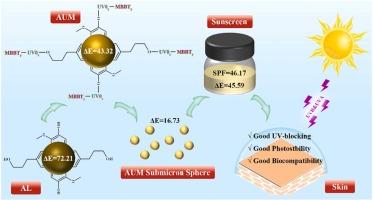防晒用木质素三元共聚物亚微米球的合成
IF 6.2
1区 农林科学
Q1 AGRICULTURAL ENGINEERING
引用次数: 0
摘要
木质素是一种天然的抗紫外线生物聚合物,使用木质素作为防晒添加剂是木质素增值的一个有吸引力的策略。然而,它的深色和抗紫外线性能的变化严重阻碍了它作为商业防晒成分的应用。在本研究中,对一种商品碱木质素(AL)进行了改性,使其抗紫外线性能和颜色显著提高。通过原子转移自由基聚合反应将二羟基二苯甲酮(UV0)和亚二苯并三唑基四甲基丁基苯酚(MBBT)接枝到AL上,得到AL-g-UV0/MBBT (AUM)三元共聚物。随后,采用溶剂移位法组装了亚微米AUM球。对AUM及其亚微米球的理化性质进行了表征。结果表明,资产的色差值(ΔE)亚微米球明显与艾尔从16.73降至72.21。此外,在资产管理领域的应用防晒霜,防晒系数(SPF)显著提高至46.2 10 %装载在同一加载与AL 4.2相比,ΔE是减少到45.59比65.86 AL。这项研究提供有用的信息和见解lignin-containing防晒霜的设计和开发。本文章由计算机程序翻译,如有差异,请以英文原文为准。

Synthesis of lignin terpolymer submicron sphere for sunscreen application
Lignin is a natural anti-UV biopolymer, and the use of lignin as a sunscreen additive is an attractive strategy for lignin valorization. However, its dark color and the variation in anti-UV performance seriously hinder its application as a commercial sunscreen ingredient. In this study, modification of a commercial alkali lignin (AL) is undertaken to significantly improve its anti-UV performance and color. Two small molecule UV absorbers, dihydroxybenzopheone (UV0) and methylenebis-benzotriazolyl tetramethylbutylphenol (MBBT) were grafted onto the AL via atom transfer radical polymerization reaction, leading to a terpolymer, AL-g-UV0/MBBT (AUM). Subsequently, submicron spheres of AUM were assembled by the solvent shifting method. The physio-chemical properties of AUM and its submicron spheres were characterized. The results showed that the color difference value (ΔE) of AUM submicron spheres was significantly reduced to 16.73 from 72.21 with AL. Moreover, with the application of AUM spheres in sunscreen, the sun protection factor (SPF) was significantly improved to 46.2 at 10 % loading compared to 4.2 with AL at the same loading, and the ΔE was reduced to 45.59 compared to 65.86 with AL. This study provides useful information and insights into design and development of lignin-containing sunscreens.
求助全文
通过发布文献求助,成功后即可免费获取论文全文。
去求助
来源期刊

Industrial Crops and Products
农林科学-农业工程
CiteScore
9.50
自引率
8.50%
发文量
1518
审稿时长
43 days
期刊介绍:
Industrial Crops and Products is an International Journal publishing academic and industrial research on industrial (defined as non-food/non-feed) crops and products. Papers concern both crop-oriented and bio-based materials from crops-oriented research, and should be of interest to an international audience, hypothesis driven, and where comparisons are made statistics performed.
 求助内容:
求助内容: 应助结果提醒方式:
应助结果提醒方式:


